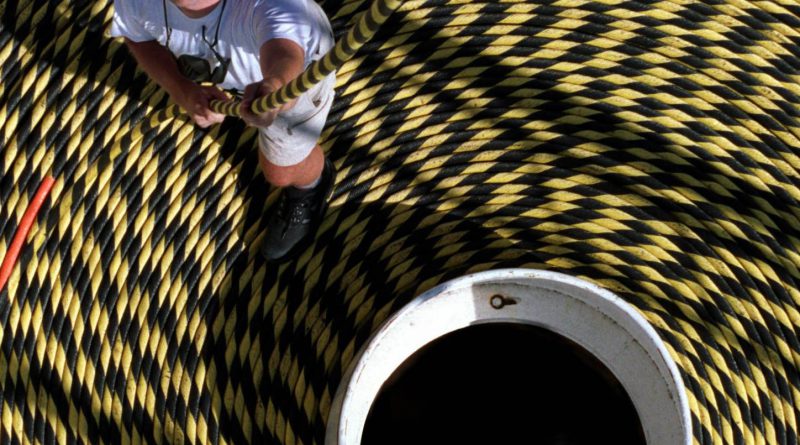How our Internet cables can detect underwater earthquakes
Thousands of miles of undersea cables support our voracious demand for communication.
In the future, they also could reveal watery earthquakes.
In a startling finding in Monterey Bay, local scientists recorded seismic waves from a magnitude 3.4 earthquake near Gilroy as a long underwater fiber-optic cable strained and shifted.
“The cable moved with the seafloor, experiencing a small little stretch,” all captured by computer, said geophysicist Nate Lindsey, a UC Berkeley graduate student and lead author of the new research, published in Thursday’s issue of the journal Science.
The discovery suggests an important new use for the cables of our vast global undersea telecommunications network, laid by phone companies and also tech giants like Google, Amazon, Facebook and Microsoft.
These cables could serve as sensitive measures of Earth’s movement, allowing earthquake monitoring in hard-to-reach areas.
Inside the cables, buried just a few feet deep, are long glass fibers. On a stream of light, via photons, they carry our Internet and phone traffic – linking continents.
Fast, smooth and flawlessly, data rushes along these glass superhighways. It travels along the glass fibers at a steady rate of 10,000 to 100,000 laser pulses per second – until the earth shrugs.
Just a few nanometers of fiber movement upsets the parade of pulses.
Lindsey was in the middle of a four-day experiment in March 2018 when Gilroy rattled.
With a team from UC Berkeley, Lawrence Berkeley National Laboratory, Monterey Bay Aquarium Research Institute and the Houston-based Rice University, he was studying signal transmission along a permanent research cable that stretches from Moss Landing out to the deep Monterey Canyon – across the major San Gregorio Fault and several smaller fault zones.
To us, the earthquake was barely perceptible. Gilroy sits between three major fault lines – the Calaveras to the east, and the San Andreas and Sargent to the west – and is chronically restless.
But it created mayhem among the cable’s photons.
As the cable stretched, “the big train of photons, moving in a pulse, got knocked around, and sent back and forth,” said Lindsey.
“We see the wave front moving” as seismic energy flowed from its Gilroy epicenter out to sea, he said.
“Then we see the scattering” of light energy, especially where the cable stretched across the San Gregorio Fault Zone.
Almost instantly, a 12.5-mile stretch of undersea fiber-optic cable was serendipitously turned into the equivalent of 10,000 seismic stations along the ocean floor.
“We lucked out,” said Lindsey. “As soon as it happened, I rushed to the hut and downloaded data,” he said. Using software, it was converted into an image.
“It looked like a big messy wavefield of seismic waves,” he said. “It is very cool.”
Larger quakes would create a bigger mess than smaller ones, because the amplitude of the cable’s stretch is directly related to the magnitude and location of the earthquake.
“This is really a study on the frontier of seismology, the first time anyone has used offshore fiber-optic cables for looking at these types of oceanographic signals or for imaging fault structures,” said Jonathan Ajo-Franklin, a geophysics professor at Rice University in Houston and a faculty scientist at Berkeley Lab.
On dry land, we have plenty of earthquake detectors.
But few seismic stations exist out at sea, leaving more than two-thirds of Earth’s surface without instrumentation.
“One of the blank spots in the seismographic network worldwide is in the oceans,” said Ajo-Franklin.
The ultimate goal of the researchers’ efforts is to use the dense fiber-optic networks around the world – probably more than 6.2 million miles in all, on both land and under the sea – as sensitive measures of Earth’s movement.
The cables can also measure the fierceness of waves out at sea, because waves push on the ocean floor.
These networks are growing as more businesses rely on global cloud computing services and storage.
Earlier this year, the team reported the results of a six-month trial of seismic activity on land using 14 miles of “dark’ cable near Sacramento.
But to make use of the world’s “lit” network, the team first needs to prove it won’t disrupt commerce. It is now conducting experiments in “lit” fibers in a seismically active region near Southern California’s Salton Sea, seeking to ping laser pulses through one channel of the fiber optic cable – without interfering with other busy channels in the fiber.
“The beauty of fiber-optic seismology is that you can use existing telecommunications cables without having to put out 10,000 seismometers,” Lindsey said. “You just walk out to the site and connect the instrument to the end of the fiber.” – The San Jose Mercury News/Tribune News Service
Source: TheStar

